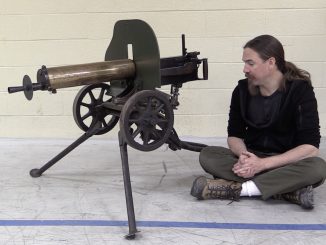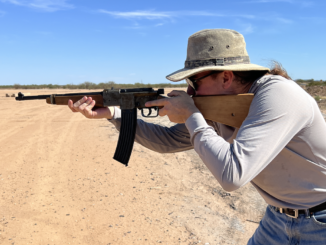In 1959 the German military first adopted the Spanish CETME as its standard infantry rifle, because it was able to acquire a license to manufacture the guns domestically (something FN had been unwilling to grant for the FAL). The European rights to the CETME were at that time owned by NWM in the Netherlands, and Germany negotiated a trade to allow its own production. That production was undertaken by two different firms – Rheinmetall and Heckler & Koch.
Ultimately Rheinmetall’s quality was sub-par, and production of the G3 would transfer entirely to H&K – but not before Rheinmetall made a number of international commercial sales of the gun. This particular example is one of a batch purchased by the Indonesian Air Force, and it sports a collapsing stock that was made between 1959 and 1961 – substantially predating the H&K collapsing stocks.
These Indonesian rifles were used by Indonesian paratroops in fighting on Papua New Guinea, where the Indonesian military was attempting to take over control of the country from the fledgling independence movement (which was supported by the Dutch government). This rifle was captured by the Papua Volunteer Corps in the early 1960s, and ultimately handed over to the Dutch military, from whence it found its way into the Dutch Military Museum.
Thanks to the Dutch National Military Museum for allowing me access to film this rifle!




My impression up to this point was that the HK were originators of all the pretty sheet-steel stampings. Now seeing the Rheinmettal version which predated it, leaves in doubts. Was it then CETME who had all worked out previously? But then, CETME rifle is quite different from standard G3. Hopefully someone will clear it for me.
As usual, good show & tell; appreciate it.
Here’s a safe bet- it was German engineers (presumably ex-Mauser) who done it.
That would be my understanding – they were there, working on it in advance and once German gov’t said “go” it was transferred to Germany to whoever was the chosen vendor.
I don’t know, but CETME was developed using the late STG 45(M) roller-delayed rifles as templates, right? Stampings would have been expected given the reference materials at hand.
There are quite a few step between STG 45 and G3, not to say (again) Cetme rifle. It also takes some time to proof and debug the tooling. If you look at result, it is top notch.
German engineers were working on the Stg 44 when war ended. This was the first roller delayed assault rifle. In Spain they worked for CETME and produced model C in 7.62 NATO. That was mass produced and shows up in surplus as “CETME”. Germany adapted it as G3 after dropping FAL. Earliest G3 rifles were CETME mod C rifles. Engineers were able to return to Germany about then. Many parts are interchangable between G3 and CETME mod C. However the engineers made several improvements for G3. Often now you will find CETME C built with G3 improvements.
Some confusion still exists over the distinctions between Papua New Guinea [ the independent nation in the eastern half of the island of New Guinea ] and Papua [ the western half of the same island that eventually became known as Irian Jaya or Irian Barat ( “Barat” means “West” in the Malay and related Indonesian languages ), and now as Western New Guinea, after the Indonesian take-over ].
The Indonesians therefore did not attempt to take control of Papua New Guinea as we know it, but rather of Papua. The antecedents of this conquest go back to Indonesia having been a former Dutch colony ( the Netherlands East Indies ), and the Dutch territory of Papua was a natural extension on the easternmost fringes of that far-flung colonial empire. hence the Indonesian claim to Papua. Also, the large, virgin territory of Papua was seen as ideal in fulfilling the ongoing Indonesian policy of transmigration whereby native Indonesians were ( and still are ) encouraged to settle in the less-populated outlying areas of the Indonesian Archipelago, which helps to relieve population pressures on the main island of Java and simultaneously integrate these areas into the greater nation as a whole.
Papua New Guinea, on the other hand, was under Australian mandate and therefore not considered to be a legally or historically supportable territorial claim by the Indonesian Government, and was thus left alone. It achieved full independence on December 1st, 1973, and is officially referred to as the Independent State Of Papua New Guinea.
The SAU CIE VII marking you were wondering about is short for : Saudagar Angkatan Udara 7th Compagnie which translates as traded / bought for Air Force ( Angkatan Udara is the Airforce part of the Tentara Nasional Indonesia, the Indonesian Army.) 7th Compagnie then being the Para-compagnie. Markings are rather outdated as the TNI changed names quite a bit.
Btw, if i had known you came to Holland, i would have liked to meet you in person. 🙂
I knew nothing of Holland’s last armed involvement with the Indonesian Archipelago. but do now. Thank you.
Indonesia is a massively spread nation, which (I think) is the largest Muslim country on Earth, but which has many, many other faiths and groups. It would repay study for anyone interested in how real countries really are born (and maybe die).
I knew of the British Army’s involvement in the formation of the State. It is probably still is part of SAS myth repeating.
The wiki on Britain’s fight against Indonesia is confused. I guess the same conflict appears under other wiki’s; none of which will bare any relation to the things I read in Britain in the late 70’s .
The wiki on the British part of Indonesian birth is below, though I’d like to read about what the Dutch were doing before hand.
https://en.wikipedia.org/wiki/Indonesia–Malaysia_confrontation
British arrived in Indonesia in 1945 with the primary goals of disarming and repatriating surrendering Japanese troops. As the ally of the Netherlands, they will naturally allow the re-establishment of Dutch East Indies. However, Indonesian independence has been declared on 17 August 1945, various independence fighter groups emerged that captured a huge mass of Japanese armaments. This went against the goal of British to disarm the Dutch East Indies. This culminated with the Battle of Surabaya at November 1945. The city was eventually captured by British, but it’s only the start of the long struggle until European forces left Indonesia in 1949. Except for Papua. Indonesians believe that any former territory of Netherlands in South East Asia should be united under Indonesia.
After massive purchase of armaments by the Indonesian government, Netherlands agreed to withdraw. In the current Reformasi era, West Papua is continuously being developed and in many cases, already surpasses the neighboring PNG. The propaganda of genocide in West Papua is a myth. There’s no proof that there’s an ongoing massacre in West Papua, tourists can go to more and more areas in West Papua safely. From the economic ruins in 1998, Indonesia economy is quickly growing and currently reached 7th largest globally. The extra money allows for infrastructure development in Papua. All projections show that Indonesia will become 4th largest economy in a few decades, just under the United States (China 1st and India 2nd). It means that West Papua will continue to be well developed. Economically, it’s the Asia century….
As a follow-up to my previous comments about the differences between Irian Jaya / Western New Guinea and Papua New Guinea and the encouragement of transmigration by the Indonesian Government, I should have added that said transmigration policies have, unfortunately, sometimes also resulted in large-scale local cultural, religious and socio-economic disruptions that have led to armed rebellion and civil war, as in the case of Irian Jaya and East Timor.
Just a point of clarification the term Papua New Guinea seems a bit problematic albeit not entirely innacurate because it is the name of the free neighbouring country on the eastern side of the island. It seems both the terms Papua and New Guinea were applied to both sides of the island which have generally fallen under Dutch colonisation on the west and German and British Empire in the East with Papua New Guinea becoming an Australian protectorate and finally becoming independent. Whilst the west side has been split into two provinces and is still effectively experiencing colonisation and exploitation along with media exclusion.
Agreed. I am hopeful, though, that the current Indonesian Government under President Joko Widodo is pursuing a more open and inclusive policy in Western New Guinea versus those of his predecessors. He seems to be a much more progressive and thoughtful policy maker and is trying to balance the traditional values of his people with the better aspects of modern-day cultural tenets. We will have to see if he succeeds in this quest to the benefit of all ethnic groups under his charge, Including the Timorese and Papuans.
By the way, do you know that President Widodo is an ardent Metalhead ( big fan of metallic rock )?
Do note that the HK early collapsible stock had concave butt plate like the this example. However the locking mechanism is very different. Later models have a convex shape. This outward curve made it easier to fire grenades. However it is very uncomfortable and awkward for normal use. I have used replacement rubber pads to give it a near flat shape. Much better that way. Length is not adjustable with HK version. Is this example adjustable? I have read of users machining additional notches to make HK version adjustable.
HK uses a concave shape for MP5 collapsible stock, just like this example.
HK uses a concave shape for MP5 collapsible stock, just like this example. The infamous G3A4 convex “meat tenderizer” design was thankfully dropped.
Here is, the rest of the story…
https://loadoutroom.com/thearmsguide/weird-gun-wednesday-wunderwaffe-mg42-sturmgeweher/